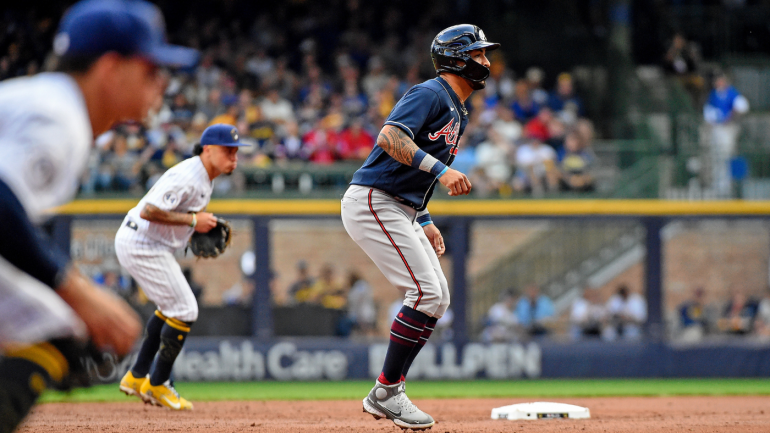
The extra-innings ghost-runner rule may not be going away just yet. MLB and the MLBPA are discussing bringing the rule, which places a runner at second base at the beginning of every half-inning after the ninth inning, back as part of the league's health and safety protocols for the 2022 season, report The Athletic's Matt Gelb and Jayson Stark.
No agreement has been reached on the tiebreaker rule or the healthy and safety protocols in general, though several players told Gelb and Stark they expect the rule to return in 2022. MLB and the MLBPA agreed to do away with the rule, as well as seven-inning doubleheader games, as part of the new collective bargaining agreement. The healthy and safety protocols are expected to be announced later this week.

CBS Sports HQ Newsletter
Your Ultimate Guide to Every Day in Sports
We bring sports news that matters to your inbox, to help you stay informed and get a winning edge.
Thanks for signing up!
Keep an eye on your inbox.
Sorry!
There was an error processing your subscription.
Also on Monday, Major League Baseball announced a series of rule changes will be tested in the minor leagues this season. Almost all the rule changes, or some variant of the rule changes, were tested in one minor league or at one level of the minors last year, and are being expanded on this year.
"Given the positive results of recent years, we are continuing to prioritize the kinds of experimental rules that many baseball fans routinely discuss and want to learn more about," Michael Hill, MLB's senior vice president of on-field operations, said in a statement. "The testing throughout the Minors will provide us with more valuable feedback and data that can be taken into consideration."
Here are the rules that will be tested in the minors this season:
Pitch timer: Timers will be used at every level. MLB has tested pitch clocks at different levels using different time limits over the years, including a 17-second clock in Low-A last season. MLB is said to be seeking a 14-second pitch clock with the bases empty and a 19-second pitch clock with men on base at the big-league level in 2023.
Larger bases: Bases will be increased from 15 inches by 15 inches to 18 inches by 18 inches at every level. The larger bases were used at Triple-A last season. The intention is cutting down on collisions and injuries, and and promoting aggressive baserunning by shortening the distance between bases. This is another rule MLB would like implemented in the majors in 2023.
Defensive position: Otherwise known as a ban on field shifts. At Double-A, High-A, and Low-A, the defense must keep four players on the infield with two completely on either side of second base. Last year different versions of the shift ban were tested at Double-A, including keeping four fielders on the infield without mandating which side of the second base they could play.
Automated strike zone: The automated ball-strike (ABS) technology will be used in "select games" at Triple-A and Low-A. In Low-A, there will be "challenge" games with a human umpire in which the pitcher, catcher, and batter can appeal the umpire's call to ABS. Each team will receive three challenges per game and retain any successful appeals. Baseball's replay process can be tedious, though Baseball America's J.J. Cooper says the appeal to ABS should only take about five seconds.
"This year's set of experimental rules was informed – and we believe improved – by the feedback of players, staff, umpires and fans, as well as by analysis of the impacts of last year's tests," Theo Epstein, a consultant to MLB, said in a statement. "We are excited to roll out the improved rule experiments to a bigger population of minor league players in an effort to ensure that any potential new regulations fulfill their objectives of creating more action, athleticism and a better style of play."
As well, the league is also a testing a new set of rules in the MLB-partnered Atlantic League, which has served as a rules laboratory of sorts in recent seasons:
Adjusted "double-hook" designated hitter rule: Last season, Atlantic League lineups lost their DH when the starting pitcher was removed from the game. This season, however, teams will be able to keep the DH for the entirety of the game in question so long as that team's starting pitcher works at least five innings. This is, obviously, designed to promote longer outings by starting pitchers.
Dropped-pitch rule: This brings back a wrinkle that was in place during the second half of the 2019 Atlantic League season. Batters may advance to first base on any pitch that the catcher fails to secure, not just a dropped third strike. They can also advance even if first base is occupied. Batters that successfully reach first base on such a play will be credited with a hit.
Of these experiments, Michael Hill, MLB's Senior Vice President for On-Field Operations, said: "Given the positive results of recent years, we are continuing to prioritize the kinds of experimental rules that many baseball fans routinely discuss and want to learn more about. Testing in the Atlantic League and throughout the Minors will provide us with more valuable feedback and data that can be taken into consideration."
As part of the new collective bargaining agreement MLB and the MLBPA created a new rules committee to explore and propose rule changes. The committee will include four active players, one umpire, and six people appointed by MLB. The league has the majority and will be able to ram through any rule changes, though they must be made with at least 45 days notice in the offseason.


















